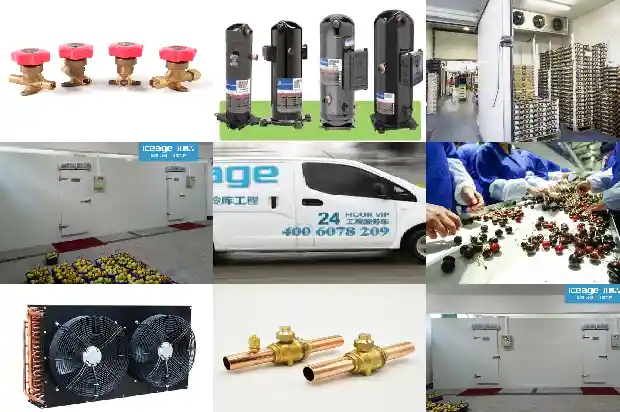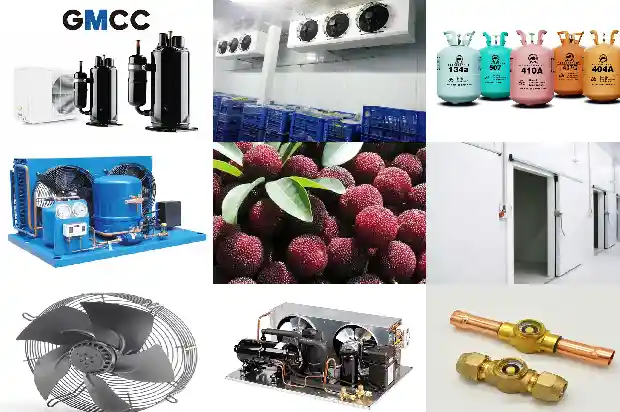Refrigeration Components of Refrigeration
2025-02-25
The refrigerant vapor of the compressor enters through the suction port on the motor side, flows through the coils, crankcase, and the suction valve plate of the valve plate, and then enters the piston cylinder. It is then compressed in the piston cylinder. When the exhaust valve plate on the valve plate opens, the gas is discharged to the high - pressure side and flows to the oil separator or condenser. For a piston compressor that has been shut down for a long time, the crankcase heater should be operated for a certain period before startup.
The shut - off valve is a manually - operated valve for cutting off or connecting the pipeline, generally used for larger pipelines.
The ball valve is a manually - operated valve for cutting off or connecting the pipeline, usually used for smaller copper pipelines.
The hand valve is a manually - operated valve for cutting off or connecting the pipeline, typically used for thinner copper pipelines like oil pipes.
Each unit is equipped with a set of pressure gauges, including a high - pressure gauge and a low - pressure gauge, which are used to monitor the system pressure and correct the sensor pressure.
The safety valve is generally installed on the top of pressure vessels (such as receivers, water - cooled condensers, evaporative condensers) (the opening pressure is generally 2.4 MPa for reference).
The liquid - supply and vapor - return filters can efficiently remove residual moisture, impurities, and acidic substances in the system. The filters equipped with the unit have replaceable filter elements.
Parallel units are all equipped with an oil filter, which can remove impurities in the oil circuit.
Each piston compressor is equipped with a protection device (e.g., INT69VS), which provides motor/exhaust over - heat protection and compressor start - stop frequency protection to ensure the compressor operates under safe working conditions.
Each piston compressor is equipped with an oil - pressure switch to prevent the compressor from running for a long time when the oil pressure difference is too low (in some cases, it means lack of oil). If the oil pressure difference is too low, the oil - pressure - difference switch will act and the compressor will stop.

The oil - level controller controls the opening and closing of the oil injection port according to the oil level in the compressor crankcase sensed by the oil - level sensing component, thereby adjusting the oil level of the compressor.
The thermostatic expansion valve regulates the refrigerant flow rate through the evaporator to maintain a pre - set temperature difference or superheat between the refrigerant in the evaporator and the refrigerant vapor at the evaporator outlet. When the temperature of the refrigerant gas leaving the evaporator changes, the temperature - sensing bulb of the expansion valve senses the temperature and adjusts the refrigerant flow rate through the expansion valve as needed.
The end - of - line filter is installed behind the end - of - line ball valve to prevent granular objects from flowing into the end - of - line solenoid valve and expansion valve along with the refrigerant, thus affecting the operation of these valves.

The shell - and - tube condenser has the advantages of a high heat - transfer coefficient and low cooling water consumption. An air - release cock is installed on the upper side of the condenser end cover to release air when filling with water, and a drain cock is installed at the bottom to drain all the water when the condenser is out of use in winter, so as to avoid cracking the heat - transfer tubes due to freezing.
Related Articles
- Refrigeration System: Copper Pipe Welding and Flushing Operations
- Have You Encountered the Three Common Problems of Refrigeration Compressors?
- How to Calculate Refrigeration Load? And What Are the Issues?
- What to Do if the Compressor of a Frozen and Refrigerated Display Cabinet Runs but the Refrigeration Effect Is Poor?
- Instructions for Welding and Drainage in the Installation of Refrigeration Equipment Pipelines
- Common Pressure Valves and Protection Devices in Refrigeration Units
- Precautions for Using Rotary Refrigeration Compressors
- What Misconceptions Should Be Avoided in Low - temperature Refrigeration System Repairs
- Essential for Maintenance! Parameters and Phenomena of Normal Operation of Refrigeration and Heating Systems
- Composition and Common Faults of Screw Refrigeration Compressors
- How to Read the High - and Low - Pressure Gauges of Refrigeration Air - conditioners?
- What is Cascade Refrigeration?
- Introduction to Control Valves in Refrigeration Systems
- Welding Equipment Used in Refrigeration System Maintenance
- Where Lie the Key Construction Technologies of the Ammonia Refrigeration System?
- What to Do When a Refrigeration Unit Malfunctions?
- Could a Tiny Copper Tube Cause a Multi - split Air Conditioner to Stop Cooling? Refrigeration Workers Must Pay Attention!
- Has Your Refrigeration System Experienced "Oil Carry - over"?
